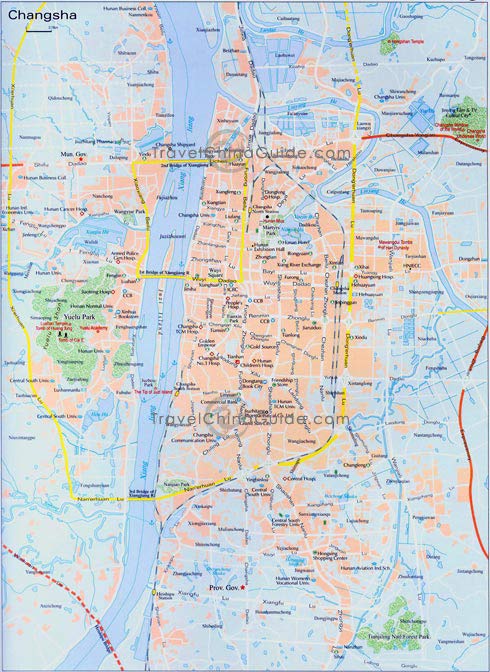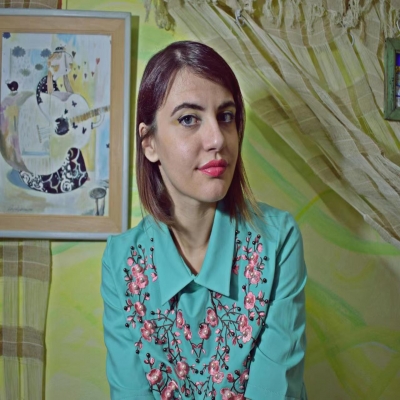Changsha Facts
Chinese Name: 长沙 (cháng shā)
Population: 8,394,500
Area: 11,819 square kilometers (4,563 square miles)
Location: in the northeast of Hunan Province, south-central China
Administrative Division: 6 districts (Furong, Tianxin, Yuelu, Kaifu, Yuhua, Wangcheng); 1 county (Changsha); 2 county-level cities (Liuyang, Ningxiang)
Area Code: 0731
Zip Code: 410000
GDP (2019): CNY 1,157.422 billion (USD 167.767 billion)
China’s Important Agriculture & Intellectual Center Highlighting Delicacies
Changsha, the capital of Hunan Province, is located in the northeast of Hunan Province, downstream of the Xiangjiang River. It is adjacent to Yichun and Pingxiang of Jiangxi Province to the east, Loudi and Yiyang to the west, Zhuzhou and Xiangtan to the South and Yueyang to the north. This city has been an important grain production base in China since ancient times. Being an intellectual center, Changsha has over 100 research institutions and engineering laboratories. Hybrid rice breeding and the Tianhe supercomputer are the main scientific research achievements.
You will be surprised by the city’s stunning natural landscape when you visit here. The green and verdant Mt. Yuelu stands in the city and Xiangjiang River is clear as a mirror passing through the city. Orange Isle lies in the heart of the river. On Saturday night, the Orange Island firework show presents a visual feast to local people and visitors. In addition, Changsha is also a city of media art and a food paradise. A great number of cultural theme parks, cultural activity centers, libraries and outdoor concert halls can be found in this city. Fabulous snacks and delicacies can be seen everywhere on the streets among which the Stinky Tofu is a must-try. The most popular food streets in Changsha include Pozi Street, Taiping Street, Dongguashan Food Street, Nanmenkou Snack and Duzheng Street.

History
The recorded history of Changsha can be traced back 3,000 years. Tomb relics from the primitive periods witnessing the earliest human activities have been discovered in this region.
During the Spring and Autumn Period (770 B.C. - 476 B.C.), the area developed into an important town within the State of Chu, one of the seven warring states that existed before China's unification by Emperor Qin. After Emperor Qin, the first feudal emperor in China's history, unified the country, the town was set up as a county and later became the capital city of a state in the early Han Dynasty (206 B.C. - 220).
In the dynasties that followed, Changsha experienced several expansions and during Qing Dynasty (1644-1911), it has developed into the political, economic and cultural center of Hunan Province.
Attractions
Although not as ancient a capital city as Beijing, Nanjing or Xi'an, Changsha also has rich historical heritages including old wall remains, tomb sites, religious temples and buildings. What earns the city its reputation among visitors are two things. One is a great man in recent history, Chairman Mao Zedong and the other is Yuelu Academy, a time-honored academic school perched on the scenic Mt. Yuelu. Originally built in 976 during the Song Dynasty, the academy school survived through the Yuan, Ming and Qing dynasties and is considered to be the cradle of Huxiang Culture, simply means the culture school in Hunan Province. Orange Isle, which is 1.2 miles (2 km) from the East Gate of Mt. Yuelu, is also worthy visiting.
Mawangdui Han Tombs found in the eastern suburb of Changsha is a family graveyard from the early Han Dynasty. The most fantastic historical relic should be the well-preserved mummified remains of a Western Han Dynasty woman excavated from the tombs. Some of thousands of relics unearthed include silk products, paintings, lacquer works, potteries, bamboo slips used for writing, weapons and herbs, all of which are exhibited in Hunan Provincial Museum. In addition, the cultural relics on display in Changsha Museum from Paleolithic age to modern times are also worth seeing.
Mt. Shaoshan, about 130 kilometers south-west of Changsha is the hometown of Chairman Mao Zedong. Today, the village has become a memorial place for Chinese people to remember this extraordinary man. People erected a statue of the Chairman and have preserved the houses he lived as a tourist site. A museum and other memorial spots in the scenic area create a kind of solemn atmosphere. Many Chinese come to pay respect and visit here during the memorial days.
Changsha was home to other revolutionary leaders including Liu Shaoqi, Huyaobang and former Chinese prime minister, Zhu Rongji. Therefore, it acts as a good place to learn more about China's recent history. Huaminglou, the hometown of Liu Shaoqi, has also been opened to the public.
Changsha Travel Tips
Dining
Changsha people boast to be the best gourmand of China and here people spend a lot of time eating. Xiang Cuisine is one of the Eight Cuisines in China and has a fine and delicate appearance and a hot & sour taste and the heavy and hot taste is an equal competitor to the spicy food of Sichuan. Street dining and restaurants in the city make every visitor's mouth hot. No matter the featured snacks - 'Stinky Tofu' and 'Sisters' Rice Balls' in Huogongdian (Fire Palace) or the famous spicy shrimps at Nanmenkou, the many types of delicious local food will not disappoint any guests.
Shopping
South Huangxing Road is highly recommended for shopping. Old Changsha can be felt along the road. Middle Jiefang Road is regarded as the Ladies Street, where girls can find the most fashion clothing they are seeking for. On Wenyun Street and Changkang Road can you find the fake articles of international brands like the Silk Market in Beijing.
Nightlife
People in Changsha are also renowned for their acting and have created various traditional folk art performances of their own including the local operas, storytelling, drum opera, acrobatics and other dramatic styles. Everyone can feel their hospitalities and enthusiasm by their vigorous dances. Today, most of the entertainment houses in the city present dynamic and entertaining performances featuring a blend of the traditional essence and the modern flare. The neon lights of KTV squares, disco parlors, clubs and dancing squares illuminate the city at night. Dotted with all sorts of bars and pubs, Jiefang Xilu, although not as prosperous as Sanlitun Pub Street in Beijing, has its own styles. Romantic and quiet bars, dynamic show bars, teahouses, western style restaurants... People of all ages can find their ideal place to spend their leisure time.
![]() Changsha has adopted the 72-hour visa-free transit policy since January 1st, 2016. The policy is open to the passport holders of eligible countries transiting at Huanghua International Airport. With the implement of this policy, the city will welcome more visitors.
Changsha has adopted the 72-hour visa-free transit policy since January 1st, 2016. The policy is open to the passport holders of eligible countries transiting at Huanghua International Airport. With the implement of this policy, the city will welcome more visitors.
Changsha Transportation -- Getting There
Air
![]() Changsha Flights
Changsha Flights
Changsha Huanghua International Airport was built in 1986 and was put into operation in 1989. It has become the largest airport in Hunan Province and one of the major domestic airports in China. It has an annual transport capacity surpassing ten million passengers. The airport serves more than 110 regular flight routes to 81 cities at home and abroad. There are 43 Chinese and foreign airline companies operating in this airport, including China Southern Airlines, Xiamen Airline, etc.
Train
![]() Changsha Railway Station
Changsha Railway Station
As an important hub of the national Jingguang Railway (Beijing-Guangzhou), Changsha benefits from rail connections to almost every major city in China. Everyday, there is a bullet train departing from Shanghai South Railway Station and arrive in the city in 8 hours. For passengers who would like to visit the charming Fenghuang Cheng (Phoenix Town), they could take trains here to Jishou and then transfer to Fenghuang by bus.
Address: Chezhan Road, close to Wuyi Dadao
City-buses: 114, 602, 139, 317, 401, 1, 7, 9, 12, 101, 104, 107, 108, 110, 111, 112, 113, 117, 118, 121, 126, 127, 135, 136, 148, 158, 168, 202, 312, 803, 801, Tour Special Line 1, Tour Special Line 3, Li Shan Line
How to get to Huanghua Airport: At the railway station, passengers could take the city-bus 114 to get there directly in 1 hour.
Alternatively, passengers could go to the Civil Aviation Hotel, which is located in the walking-distance from the railway station. Here, the airport shuttle bus could be caught, which could get to the airport in 40 minutes.
![]() South Railway Station
South Railway Station
This railway station was built to serve the bullet trains running along the Wuhan-Guangzhou High Speed Railway. Currently, there are over 50 high speed trains departing and stopping at this railway station. The train only takes about 1.5 hours running to Wuhan, and about 2~2.5 hours to Guangzhou from this city.
Address: Lituo Town, Yuhua District (about 10 kilometers away from city center)
City-buses: 63, 503, 66, 159, 160, 348, 16, 124 (04:00~ the next 01:00), 135 (04:00~ the next 01:00)
To the Railway Station: 159 (50 minutes)
To South Bus Station: 16
To North Bus Station: 159
To West Bus Station: 348, 63, 66
To Huanghua Airport: Please take a city-bus or cab to arrive at the Railway Station or South Bus Station, both of where the airport shuttle bus could be caught.
![]() Ticket: Tickets can be booked at railway stations, online or through phone. Thera are also many ticket offices in the city providing ticket booking and collecting services (currently only Chinese citizens can book or collect tickets at the ticket offices due to the identity verification policy. Foreign passengers can only book at railway station or with agencies and collect their tickets at railway stations)
Ticket: Tickets can be booked at railway stations, online or through phone. Thera are also many ticket offices in the city providing ticket booking and collecting services (currently only Chinese citizens can book or collect tickets at the ticket offices due to the identity verification policy. Foreign passengers can only book at railway station or with agencies and collect their tickets at railway stations)
| Ticket Agency | Address | Telephone |
| South Railway Station Agency | No. 2, Shuyuan Road | 0731-85825507 |
| China Youth Travel Agency | No. 46, Zhanlanguan Road | 0731-82232215 |
| Renmin Lu Agency | No.158, Renmin Road | 0731-85505702 |
| Jiefang Lu Agency | No.48, Jiefang Road | 0731-84436130 |
| Hunan Normal University Agency | Tourist School of Hunan Normal University | 0731-88872486 |
| Tiantian Agency | 1st Floor, Zhongshan Hotel, Wuyi Road (Middle) | 0731-82222278/222 |
| Agency in Jingxin Hotel | No. 478, Fenglin Er Road | 0731-88868882 |
| Wuyi Xilu Agency | No.143, Wuyi Road (West) | 0731-84403212 |
| Deya Lu Agency | No.88, Deya Road | 0731-84556641 |
| Tianxi Agency | No.68, Chengnan Road, Tianxin District | 0731-85155796 |
| Wenyilu Agency | No.4, Jiefang Road (East) | 0731-82227544 |
| Dongtang Agency | No.482, Shaoshan Road | 0731-85513747 |
| Fenglin Agency | East end of Fengxiang Building, Hexi | 0731-88861120 |
| Ping'an Building | 1st floor, Ping'an Building, Furong Road (Middle) | 0731-84410936 |
Long-Distance Bus
Changsha is the hub of three inter-province freeways including No.107 Freeway (Beijing–Shenzhen), No.391 Freeway (Chengdu–Xiamen) and No.106 Freeway. A well developed highway network connects the city with many major destinations in China and buses leaving from the three major long-distance bus stations in the city serve most of the eastern part of the country. Although it is impossible to list all the destinations that can be reached from the three bus stations; we have listed a selection of the main and most popular ones for reference.
![]() East Bus Station
East Bus Station
Address: No. 1507, Yuanda First Road
Destinations: Hefei, Nanchang, Xiamen, Nanjing and neighboring cities in Hunan Province
Enquiry: 0731- 84611731
![]() South Bus Station
South Bus Station
Address: No.811, Zhongyi First Road
Destinations: Guilin, Xiamen, Nanjing and neighboring cities in Hunan Province
Enquiry: 0731-82805051
![]() West Bus Station
West Bus Station
Address: No. 1619, 1st Section, West Second Ring, Yuelu District
Destinations: neighboring cities in Hubei and Hunan provinces
Enquiry: 0731-88816553
![]() Intercity Commuters:
Intercity Commuters:
Changzhutan Bus Station, between the south of Friendship and Apollo Commercial Square and the local railway station, provides regular buses for Zhuzhou and Xiangtan, which are the cities where most travelers change trains from the north-south Jingguang (Beijing-Guangzhou) Railway to continue their journeys in either an easterly or westerly direction. Besides, buses to Zhangjiajie, Jishou, Wuhan, Hengyang, etc are also available at this station.




































